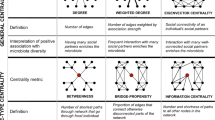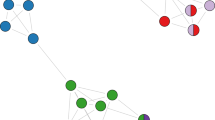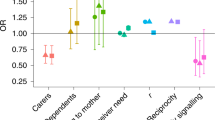Abstract
Social networks in modern societies are highly structured, usually involving frequent contact with a small number of unrelated ‘friends’1. However, contact network structures in traditional small-scale societies, especially hunter-gatherers, are poorly characterized. We developed a portable wireless sensing technology (motes) to study within-camp proximity networks among Agta and BaYaka hunter-gatherers in fine detail. We show that hunter-gatherer social networks exhibit signs of increased efficiency2 for potential information exchange. Increased network efficiency is achieved through investment in a few strong links among non-kin ‘friends’ connecting unrelated families. We show that interactions with non-kin appear in childhood, creating opportunities for collaboration and cultural exchange beyond family at early ages. We also show that strong friendships are more important than family ties in predicting levels of shared knowledge among individuals. We hypothesize that efficient transmission of cumulative culture3–6 may have shaped human social networks and contributed to our tendency to extend networks beyond kin and form strong non-kin ties.
This is a preview of subscription content, access via your institution
Access options
Access Nature and 54 other Nature Portfolio journals
Get Nature+, our best-value online-access subscription
$29.99 / 30 days
cancel any time
Subscribe to this journal
Receive 12 digital issues and online access to articles
$119.00 per year
only $9.92 per issue
Buy this article
- Purchase on Springer Link
- Instant access to full article PDF
Prices may be subject to local taxes which are calculated during checkout




Similar content being viewed by others
References
Saramäki, J. et al. Persistence of social signatures in human communication. Proc. Natl Acad. Sci. USA 111, 942–947 (2014).
Latora, V. & Marchiori, M. Efficient behavior of small-world networks. Phys. Rev. Lett. 87, 198701 (2001).
Rendell, L. et al. Why copy others? Insights from the social learning strategies tournament. Science 328, 208–213 (2010).
Powell, A., Shennan, S. & Thomas, M. G. Late Pleistocene demography and the appearance of modern human behavior. Science 324, 1298–1301 (2009).
Feldman, M. W. & Laland, K. N. Gene–culture coevolutionary theory. Trends Ecol. Evol. 11, 453–457 (1996).
Henrich, J. The Secret of our Success: How Culture is Driving Human Evolution, Domesticating our Species, and Making Us Smarter (Princeton Univ. Press, 2015).
Jaeggi, A. V. & Gurven, M. Natural cooperators: food sharing in humans and other primates. Evol. Anthropol. 22, 186–195 (2015).
Kramer, K. L. The evolution of human parental care and recruitment of juvenile help. Trends Ecol. Evol. 26, 533–540 (2011).
Granovetters, M. The strength of weak ties. Am. J. Sociol. 78, 1360–1380 (1973).
Watts, D. J. & Strogatz, S. H. Collective dynamics of ‘small-world’ networks. Nature 393, 440–442 (1998).
Hruschka, D. J. Friendship: Development, Ecology, and Evolution of a Relationship (Univ. California Press, 2010).
Salali, D. S. et al. Knowledge-sharing networks in hunter-gatherers and the evolution of cumulative culture. Curr. Biol. 26, 2516–2521 (2015).
Apicella, C. L., Marlowe, F. W., Fowler, J. H. & Christakis, N. A. Social networks and cooperation in hunter-gatherers. Nature 481, 497–501 (2012).
Uzzi, B & Spiro, J. Collaboration and creativity: the small world problem. Am. J. Sociol. 11, 447–504 (2005).
Warneken, F., Steinwender, J., Hamann, K. & Tomasello, M. Young children's planning in a collaborative problem-solving task. Cogn. Dev. 31, 48–58 (2014).
Whiten, A. & Flynn, E. The transmission and evolution of experimental microcultures in groups of young children. Dev. Psychol. 46, 1694–1709 (2010).
Lewis, H. M., Vinicius, L., Strods, J., Mace, R. & Migliano, A. B. High mobility explains demand sharing and enforced cooperation in egalitarian hunter-gatherers. Nat. Commun. 5, 5789 (2014).
Hill, K. R., Wood, B. M., Baggio, J., Hurtado, A. M. & Boyd, R. T. Hunter-gatherer inter-band interaction rates: implications for cumulative culture. PLoS ONE 9, e102806 (2014).
Dunbar, D. How Many Friends Does One Person Need? Dunbar’s Number and Other Evolutionary Quirks (Harvard Univ. Press, 2010).
Dyble, M. et al. Sex equality can explain the unique social structure of hunter-gatherer bands. Science 348, 796–798 (2015).
Hill, K. R. et al. Co-residence patterns in hunter-gatherer societies show unique human social structure. Science 331, 1286–1289 (2011).
Derex, M. & Boyd, R. Partial connectivity increases cultural accumulation within groups. Proc. Natl Acad. Sci. USA 113, 2982–2987 (2016).
Aplin, L. M. et al. Experimentally induced innovations lead to persistent culture via conformity in wild birds. Nature 518, 538–541 (2015).
Fowler, J. H., Dawes, C. T. & Christakis, N. A. Model of genetic variation in human social networks. Proc. Natl Acad. Sci. USA 106, 1720–1724 (2009).
Gross, T., D’Lima, C. J. D. & Blasius, B. Epidemic dynamics on an adaptive network. Phys. Rev. Lett. 96, 208701 (2006).
Macfarlan, S. J., Walker, R. S., Flinn, M. V. & Chagnon, N. A. Lethal coalitionary aggression and long-term alliance formation among Yanomamö men. Proc. Natl Acad. Sci. USA 113, 16662–16669 (2014).
Burkart, J. M., Hrdy, S. B. & van Schaik, C. P. Cooperative breeding and human cognitive evolution. Evol. Anthropol. 18, 175–186 (2009).
Lawler, A. Making contact. Science 348, 1072–1079 (2015).
Wohlgemuth, J. & Matache, M. T. Small-world properties of Facebook group networks. Complex Syst. 23, 3 197–225 (2012).
Albert, R., Jeong, H. & Barabási, A.-L. Diameter of the World-Wide Web. Nature 401, 130–131 (1999).
Minter, T. The Agta of the Northern Sierra Madre. Livelihood Strategies and Resilience Among Philippine Hunter-Gatherers. PhD thesis, Leiden Univ. (2010).
Page, A. E. et al. Reproductive trade-offs in extant hunter-gatherers suggest adaptive mechanism for the Neolithic expansion. Proc. Natl Acad. Sci. USA 113, 4694–4699 (2016).
Dyble, M. et al. Multi-level social organisation facilitates food sharing among small-scale hunter-gatherers. Curr. Biol. 26, 2017–2021 (2016).
Meehan, C. L., Quinlan, R. & Malcom, C. D. Cooperative breeding and maternal energy expenditure among Aka foragers. Am. J. Hum. Biol. 25, 42–57 (2013).
Dagum, C. The generation and distribution of income, the Lorentz curve and the Gini ratio . Écon. Appl . 33, 327–367 (1980).
Acknowledgements
We thank J. Lewis and R.K. Schlaepfer for help in the field. We thank R.K. Schlaepfer and RKSmedia for producing the accompanying movies, and R. Foley and J. Bertranpetit for comments. We also thank our assistants in Congo and the Philippines, as well as the Agta and BaYaka communities. This project was funded by the Leverhulme Trust grant RP2011-R-045 to A.B.M., M.G.T. and R.M. R.M. also received funding from European Research Council Advanced Grant AdG 249347. The funders had no role in study design, data collection and analysis, decision to publish, or preparation of the manuscript.
Author information
Authors and Affiliations
Contributions
A.B.M. conceived the project, S.V. designed the motes, A.B.M., M.D., J.T., A.E.P., D.S., G.D.S., N.C. and S.V. collected data, G.D.S. provided video images from Congo and collected data on plant knowledge, J.G.-G. and V.L. performed social network analysis, J.G.-G., S.V., A.E.P., M.D., D.S., N.C., J.S., J.T., V.L., L.V and A.B.M. analysed the data, R.M. commented on the manuscript, and A.B.M., L.V., M.G.T. and V.L. wrote the paper with help from all other authors.
Corresponding author
Ethics declarations
Competing interests
The authors declare no competing interests.
Supplementary information
Supplementary Information
Supplementary Figures 1-5, Supplementary Tables 1-4. (PDF 570 kb)
Supplementary Video 1
BaYaka Pygmies from Congo Brazzaville performing the ‘Bobe’ forest spirits ritual. Bobe lasts for hours during the night. Women sing polyphonic music and play drums with children. After some time, adult men believed to be possessed by forest spirits are attracted by the singing and come into the camp to dance. The ritual is believed to be important for group cohesion. The video also shows children mimicking the adult performance of the forest spirits ritual in an unsupervised play group. Video footage shot by Gul Deniz Salali between March and July 2014. Video edited by Rodolph Schlaepfer (RKSmedia). (MP4 16943 kb)
Rights and permissions
About this article
Cite this article
Migliano, A., Page, A., Gómez-Gardeñes, J. et al. Characterization of hunter-gatherer networks and implications for cumulative culture. Nat Hum Behav 1, 0043 (2017). https://doi.org/10.1038/s41562-016-0043
Received:
Accepted:
Published:
DOI: https://doi.org/10.1038/s41562-016-0043
This article is cited by
-
Shared cross-cultural principles underlie human prosocial behavior at the smallest scale
Scientific Reports (2023)
-
Intergroup Cooperation in Shotgun Hunting Among BaYaka Foragers and Yambe Farmers from the Republic of the Congo
Human Nature (2023)
-
The scaling of social interactions across animal species
Scientific Reports (2021)
-
The Relative Importance of “Cooperative Context” and Kinship in Structuring Cooperative Behavior
Human Nature (2021)
-
Food Income and the Evolution of Forager Mobility
Scientific Reports (2019)



